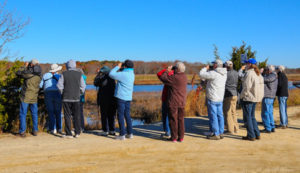by Jayne Bodner
 This past Friday, October 30, was a sunny, temperate fall day.
This past Friday, October 30, was a sunny, temperate fall day.
At 8 am we joined about 20 other people in front of the Medford Leas’ main campus Community Building for the “Medford Leas Birders Trip to Brigantine.”
The Medford Leas Birders, a group of residents who are true ‘birders,” were the organizers and gracious guides for this trip. The trip was offered through “Pathways,” a program run at Medford Leas that provides a wonderful variety of learning experiences to Medford Leas residents and to residents of the surrounding communities.
(True birders, I’ve come to understand, are people who have developed the expertise to recognize a great many birds, by sight, but also by sound. They know their habits, life cycles, migration patterns. And they venture out individually and with like minded others to look for specific birds in specific habitats and to lead bird counts and tagging projects. A hobby that can become a true advocation for some.)
When we gathered at the Community Building, people joined up to make sure everyone had a ride. Our drive down went quickly, due in part to our guest passenger, another resident, who knew far more than we did what we were driving through and what we might see.
The trip leader, one of the Medford Leas Birders, provided a set of clear directions for driving there and back (by different routes) so that the caravan drivers did not need to be anxious about staying in line. These directions were written and time tested by another of the birders. And to the relief of many, they included our lunch destination, Shea’s Café and Bakery in Galloway NJ.
The day was spent sighting birds, looking out over the Fall-hued marshlands in the Edwin B. Forsythe National Wildlife Refuge in Brigantine, to tree lines of desperate, energized color, and to the distant views of Atlantic City’s skyline. These were all set against a clarity-blue October’s sky. (The Fall sky can be such a rich, showoff color that even re-colored old Westerns can’t quite get right.)
Even with my binoculars and Audubon Field Guide (which I actually knew how to use!), I would have missed so many beautiful birds, without the true birders in our group who were generous with their knowledge of what we were seeing, and of what we could see if we just looked a little to the right, or the left, of that tree stump, or that tuft of march grass!
After we had completed the large circle around the Refuge, our trip leader gave a heads up, that it was time to head back home but first – lunch. The Café where we planned to stop for lunch had been warned of our expected arrival, and handled our large party quite well. We were seated in small groups all around their dining room, we ordered from all over the menu, and everyone seemed quite pleased with the food and the service.
Then we headed home through the Pinelands Preservation area, and through more of all the lovely color!
For more information, including a list of the birds seen and a list of future field trips, go to mlra.org/MLBirders/category/field-trips/ and mlra.org/MLBirders/edwin-b-forsythe-national-wildlife-refuge/.
The Edwin B. Forsythe National Wildlife Refuge was name for Edwin Forsythe, a South Jersey Congressman whose conservation work was honored in the naming of the Refuge. To learn more, go to fws.gov/refuge/Edwin_B_Forsythe/about.html.
And just below are places you can reach out through for information about the Pinelands preserve, and the groups working to keep it whole and safe.
The Pinelands preserve is 1.1 million acre area. There is so little built on the land that it is the largest dark area visible from space on the East Coast of North America. Preserve the Dark – warm, rich and beautiful!
– go to PINELANDSALLIANCE.ORG
– email inquiries to ppa@pinelandsalliance.org
– Facebook through facebook.com/Pinelands
– mail inquiries to Pinelands Preservation Alliance, Bishop Farmstead, 17 Pemberton Road, Southampton, NJ, 08088.
